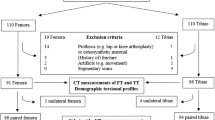Abstract
Aim
This study aims to test the accuracy and feasibility of a measurement of femoral torsion of a 3D C-arm system (Linea aspera method) in a cadaver setting.
Materials and methods
A total of 11 intact femora were used. Schanz screws were inserted in the femoral bone in a parallel manner with the help of a fixed drill sleeve. Femur bones were then fractured in a controlled manner and three different internal and external torsion angles were fixed with the help of a Goniometer. After that, a 3D scan was performed. The 3D data set was analyzed using a radiologic software (Visage 7, Visage Imaging Inc, USA). Measurements were then compared in the two methods with a dependent t test.
Results
Specific measurements for different angles did not show any differences between those two utilities.
Conclusion
Intraoperative estimation of femoral antetorsion using a 3D C-Arm system and the Linea aspera method seems to be an accurate and feasible method. Nevertheless, more studies with higher patient numbers, comparison to CT seems to be the next step and can be recommended.



Similar content being viewed by others
References
Hawi N, Suero EM, Liodakis E et al (2014) Intra-operative assessment of femoral antetorsion using ISO-C 3D: a cadaver study. Injury 45:506–509. https://doi.org/10.1016/j.injury.2013.10.034
Stübig T, Min W, Arvani M et al (2012) Accuracy of measurement of femoral anteversion in femoral shaft fractures using a computer imaging software: a cadaveric study. Arch Orthop Trauma Surg 132:613–616. https://doi.org/10.1007/s00402-011-1450-y
El-Menyar A, Muneer M, Samson D et al (2018) Early versus late intramedullary nailing for traumatic femur fracture management: meta-analysis. J Orthop Surg 13:160. https://doi.org/10.1186/s13018-018-0856-4
Cao J-Q, Huang J-H, Yuan T et al (2017) Intraoperative correction of femoral rotational deformity using a conventional navigation system and a smartphone: a novel technique. Surg Innov 24:446–454. https://doi.org/10.1177/1553350617715373
Dirhold BM, Citak M, Al-Khateeb H et al (2012) Current state of computer-assisted trauma surgery. Curr Rev Musculoskelet Med 5:184–191. https://doi.org/10.1007/s12178-012-9133-z
Kaiser P, Attal R, Kammerer M et al (2016) Significant differences in femoral torsion values depending on the CT measurement technique. Arch Orthop Trauma Surg 136:1259–1264. https://doi.org/10.1007/s00402-016-2536-3
Sathy A, Barnwell JC, Shahrestani SN, Moore D (2017) Reliable method for avoiding malrotation deformity after intramedullary nailing of comminuted femur fractures: clinical validation of a previously described technique. J Orthop Trauma 31:e121–e126. https://doi.org/10.1097/BOT.0000000000000767
Vaidya R, Dimovski R, Cizmic Z et al (2018) Use of inherent anteversion of an intramedullary nail to avoid malrotation in comminuted femur fractures: a prospective case–control study. J Orthop Trauma 32:623–628. https://doi.org/10.1097/BOT.0000000000001314
Jaarsma RL, Pakvis DFM, Verdonschot N et al (2004) Rotational malalignment after intramedullary nailing of femoral fractures. J Orthop Trauma 18:403–409
Subburaj K, Ravi B, Agarwal M (2010) Computer-aided methods for assessing lower limb deformities in orthopaedic surgery planning. Comput Med Imaging Graph 34:277–288. https://doi.org/10.1016/j.compmedimag.2009.11.003
Atesok K, Tanaka N, O’Brien A et al (2018) Posttraumatic spinal cord injury without radiographic abnormality. Adv Orthop 2018:1–10. https://doi.org/10.1155/2018/7060654
Kendoff D, Citak M, Gardner MJ et al (2009) Intraoperative 3D imaging: value and consequences in 248 cases. J Trauma 66:232–238. https://doi.org/10.1097/TA.0b013e31815ede5d
Krettek Ch, Miclau T, Gru¨n O et al (1998) Intraoperative control of axes, rotation and length in femoral and tibial fractures technical note. Injury 29:29–39. https://doi.org/10.1016/S0020-1383(98)95006-9
Hawi N, Liodakis E, Suero EM et al (2014) Radiological outcome and intraoperative evaluation of a computer-navigation system for femoral nailing: a retrospective cohort study. Injury 45:1632–1636. https://doi.org/10.1016/j.injury.2014.05.039
Kendoff D, Citak M, Hüfner T et al (2007) Current concepts and applications of computer navigation in orthopedic trauma surgery. Open Med. https://doi.org/10.2478/s11536-007-0042-2
Funding
This research did not receive any specific grant from funding agencies in the public, commercial, or not-for-profit sectors.
Author information
Authors and Affiliations
Corresponding author
Ethics declarations
Conflict of interest
Each author certifies that he or she has no commercial associations (e.g., consultancies, stock ownership, equity interest, patent/licensing arrangements, etc.) that might pose a conflict of interest in connection with the submitted article.
Additional information
Publisher's Note
Springer Nature remains neutral with regard to jurisdictional claims in published maps and institutional affiliations.
Rights and permissions
About this article
Cite this article
Stubig, T., Aidarous, H., Khalifa, A. et al. Development of an intraoperative 3D C-arm technique for torsion control of femur fractures: a cadaver study. Arch Orthop Trauma Surg 140, 1739–1743 (2020). https://doi.org/10.1007/s00402-020-03432-4
Received:
Published:
Issue Date:
DOI: https://doi.org/10.1007/s00402-020-03432-4




